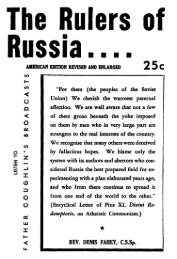education-dev-global-era-69
education-dev-global-era-69
education-dev-global-era-69
Create successful ePaper yourself
Turn your PDF publications into a flip-book with our unique Google optimized e-Paper software.
Chapter 1: Education, Globlisation and Development:Changing the Terms of Engagement – Andy Greenmanufacturing for export in the 1960s, which turned out to be the right way to go given thestate of the <strong>global</strong> economy (Schein, 1996). Lack of natural resources also, arguably, promotedthe focus on skills and human capital which coincided with the needs of the emergingknowledge economy (Castells, 1997). Insular geography gave the East Asian states a measureof territorial security at certain historical periods, and has certainly contributed to the strongsense of national identity which these states share, and which has been an advantage for nationbuilding.But the strategic location of these states has also acted as a magnet for foreignincursions and, in the case of the tigers, for colonisation by either Japan or Britain or both.While foreign threats proved a incentive to modernisation in Meiji Japan, colonisation of thelands later to become the tiger economies did not bring rapid industrial <strong>dev</strong>elopment, except inHong Kong. However, the geopolitical position of the East Asian states in the post WW2period has certainly had benefits for <strong>dev</strong>elopment.Japan, virtually a US satellite for much of the post-war period (Johnson, 2000), was therecipient of large scale US aid during and after the occupation and this helped to re-start itsindustrial economy (Johnson, 2000). South Korea, Taiwan and Singapore also foundthemselves at the centre of cold war tensions and consequently of large scale aid from both theUS and Britain during the 1950s, 1960s and 1970s. Between 1953 and 1958 South Koreareceived an av<strong>era</strong>ge of $270 m a year in aid from in the US which represented nearly 15% ofGNP (Amsden, 1992: 39). The US largely funded South Korea’s defence costs andrequisitioning for the Vietnam war later kick-started the Chaebols, the future industrial giants(Castells, 1977). Aid from the US also helped Taiwan in the early stages of <strong>dev</strong>elopment,funding 49% of public investment in infrastructure between 1953 and 1957 (World Bank,1993). Singapore also benefited economically from the presence of British military bases duringthe 1960s and from US requisitioning for the Vietnam war (Rodan, 1989).Geography and geopolitics clearly provide only partial explanations of rapid East Asian<strong>dev</strong>elopment. Other Asian states caught up in cold war tensions and benefiting from substantialUS aid, such as the Philippines, have not prospered so well. Nor economically, has anotherstrategically placed island state, Sri Lanka, although it might be argued that this country sufferedfrom the ‘impediment’ of having some rather abundant agricultural resources which deprived itof the incentive, acutely felt by the East Asian tigers, for a policy based on export-ledmanufacturing <strong>dev</strong>elopment. Nevertheless, geography and geopolitics clearly did help Japan andthe four tigers economically in the crucial periods of the economic <strong>dev</strong>elopment. Were it not forthe geographical accident of their strategic locations and long coastlines and for theireconomically fortuitous geopolitical positioning at the centre of cold war tensions in the postwar<strong>era</strong> it is unlikely that they would have <strong>dev</strong>eloped when and in the way they did.Lastly amongst the historically contingent conditions of <strong>dev</strong>elopment, timing was clearly crucialfor Japan and the East Asian tigers. Japan’s second wave of industrialisation in the 1950s andthe first industrial take-off of the tiger economies in the 1960s coincided with a buoyant periodin the world economy when trade was increasing and lib<strong>era</strong>lising but when internationalagreements still allowed flexible trade regimes in different states. As we shall see later, thesecountries made exemplary use of these favourable conditions, making the most for exports ofthe relatively open western markets and of the opportunities permissible for exportsubsidisation, whilst at the same time protecting their economies from excessive capitalDFID 27





